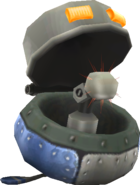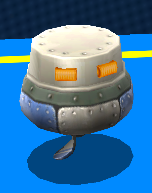Sentry Beam
| Sentry Beam | |||
|---|---|---|---|
 Model from Super Mario Galaxy | |||
| First appearance | Super Mario Galaxy (2007) | ||
| Latest appearance | Super Mario Galaxy + Super Mario Galaxy 2 (2025) | ||
| |||
Sentry Beams[1][2] are enemies in Super Mario Galaxy and Super Mario Galaxy 2. These invulnerable metallic robots attack by firing lasers from their mouths at Mario or Luigi.
History[edit]
Super Mario Galaxy[edit]
Sentry Beams debut in Super Mario Galaxy and its Nintendo Switch port. Sentry Beams are stationary robots that hover in place, firing a laser at Mario or Luigi if he approaches them. They cannot be destroyed by any means, but if Mario or Luigi stands on top of them, they cease all motion until he gets off and starts to move again.
Sentry Beams appear in the following list of galaxies and missions. If no mission is stated, Sentry Beams appear during all missions:
- Battlerock Galaxy ("Topmaniac and the Topman Tribe")
- Bowser Jr.'s Airship Armada
- Toy Time Galaxy ("Heavy Metal Mecha-Bowser", "Mario Meets Mario", "The Flipswitch Chain")
Super Mario Galaxy 2[edit]
Sentry Beams reappear in Super Mario Galaxy 2, and they are encountered only in World S, more specifically the first mission of Mario Squared Galaxy and both missions of Grandmaster Galaxy. They behave identically to their first appearance. They are now able to interact with Yoshi, who can target them with his tongue, but cannot eat them.
Naming[edit]
Internal names[edit]
| Game | File | Name | Meaning
|
|---|---|---|---|
| Super Mario Galaxy Super Mario Galaxy 2 |
ObjectData/SearchBeamer.arc | SearchBeamer | Transliteration of below |
| StageData/ObjNameTable.arc/ObjNameTable.tbl SystemData/ObjNameTable.arc/ObjNameTable.tbl |
サーチビーマー (Sāchi Bīmā) | Search Beamer |
Names in other languages[edit]
The contemporaneous name for each language is listed first. Subsequent names are listed in chronological order for each language, from oldest to newest, and have the media with which they are associated in the "notes" column. Names exclusive to localizations of the Super Mario Bros. Encyclopedia are not prioritized due to concerns about circular reporting, and are only listed first for their respective languages if they are the only ones available.
| Language | Name | Meaning | Notes |
|---|---|---|---|
| Japanese | レーザーポッド[3][4][5] Rēzā Poddo |
Laser Pod | |
| French | Pod laser[6] | Laser Pod | |
| Laserpod[7][8] | Super Mario Galaxy, Super Mario Bros. Encyclopedia | ||
| German | Laser-Roboter[9] | Laser Robot | |
| Italian | Laser Sentinella[10][11] | Sentry Laser | |
| Spanish | Unidad Láser[12]:128 | Laser Unit | |
| Láser Centinela[12]:161 | Centinel Laser |
References[edit]
- ^ Browne, Catherine (May 23, 2010). Super Mario Galaxy 2: PRIMA Official Game Guide. Roseville: Random House Inc. ISBN 978-0-30746-907-6. Page 29.
- ^ November 15, 2018. Super Mario Bros. Enciclopedia. Magazzini Salani (Italian). ISBN 889367436X. Page 127.
- ^ Aoyagi, Masayuki, editor (2007). 『スーパーマリオギャラクシーコンプリートガイド』(Super Mario Galaxy Complete Guide). Tokyo: Enterbrain (Japanese). ISBN 978-4-7577-3943-7. Page 365.
- ^ Tachibana, Tadashi, Isamu Horie, Shinji Kutsuzawa, Itaru Nakatani, Seishiro Fuwa, Kimihara Hongo, and Toshimune Suzuki (2010). 『スーパーマリオギャラクシー2 任天堂ゲーム攻略本』. Tokyo: ambit (Japanese). ISBN 978-4-8399-3630-3. Page 20.
- ^ Sakai, Kazuya (ambit), kikai, Akinori Sao, Junko Fukuda, Kunio Takayama, and Ko Nakahara (Shogakukan), editors (2015). 『スーパーマリオブラザーズ百科: 任天堂公式ガイドブック』. Tokyo: Shogakukan (Japanese). ISBN 978-4-09-106569-8. Page 128, 161.
- ^ Browne, Catherine (2010). Super Mario Galaxy 2 Prima le Guide Officiel. Translated by Yellow Media. Ligugé: Prima Games (French). ISBN 978-2-952-67394-5. Page 31.
- ^ Black, Fletcher (2007). Super Mario Galaxy Le Guide Officiel (French Edition). Translated by Mathieu Daujam and Calude-Olivier Eliçabe. Roseville: Prima Games (French). ISBN 978-1-906064-02-0. Page 31.
- ^ Ardaillon, Joanna, and Victoria Juillard-Huberty, editors (2018). Super Mario Encyclopedia. Translated by Fabien Nabhan. Toulon: Soleil Productions (French). ISBN 978-2-3020-7004-2. Page 128, 159.
- ^ Scholz, Sabine, and Benjamin Spinrath, editors (2017). "Super Mario Galaxy" in Super Mario Encyclopedia - Die ersten 30 Jahre : 1985-2015. Translated by Yamada Hirofumi. Hamburg: Tokyopop (German). ISBN 978-3-8420-3653-6. Page 128.
- ^ Browne, Catherine (2010). Super Mario Galaxy 2 Guida Strategica Ufficiale (Multiplayer.it Edizioni). Translated by Christian La Via Colli, Francesca Noto, and Virgina Petrarca. Terni: Multiplayer Edizioni, Prima Games (Italian). ISBN 9788863551198. Page 29.
- ^ Sakai, Kazuya (ambit), kikai, Akinori Sao, Junko Fukuda, Kunio Takayama, Ko Nakahara (Shogakukan), and Marco Figini, editors (2018). Super Mario Bros. Enciclopedia. Translated by Marco Amerighi. Milan: Magazzini Salani (Italian). ISBN 889367436X. Page 128, 161.
- ^ a b Sakai, Kazuya (ambit), kikai, Akinori Sao, Junko Fukuda, Kunio Takayama, and Ko Nakahara (Shogakukan), editors (2017). "Super Mario Galaxy" in Enciclopedia Super Mario Bros. 30ª Aniversario. Translated by Gemma Tarrés. Barcelona: Editorial Planeta, S.A. (European Spanish). ISBN 978-84-9146-223-1.
